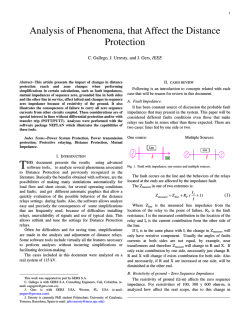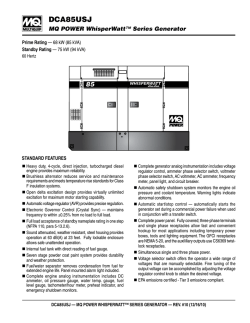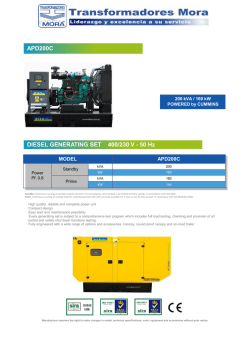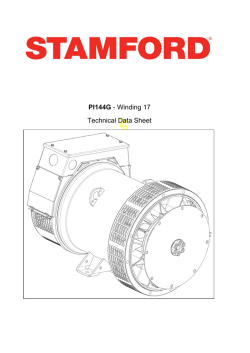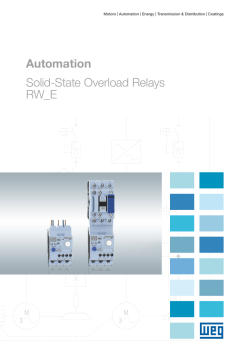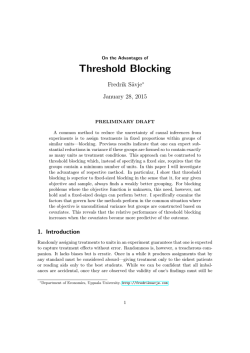
operation simulation of out of step relays using comtrade
OPERATION SIMULATION OF OUT OF STEP RELAYS USING COMTRADE FILES AND TRANSIENT STABILITY ANALYSIS Juan M Gers, PhD GERS USA Weston, Florida [email protected] James Ariza, MEGGER Dallas, TX [email protected] Abstract--The high interconnection levels of electrical systems is exposing them more to stringent operating conditions which can result in power oscillations and consequent system instability. Out to step protections are very useful to disconnect generators when genuine conditions of loose of synchronism arise and especially if the load loci crosses the impedance characteristics of the generators or their GSU transformers. Proper settings of out of step has been widely discussed and appropriate methods to simulate their effectiveness have are being proposed. This paper analyzes the benefits of the existing setting procedure and proposes efficient and practical methods to obtain results from stability programs, translated into COMTRADE formats to be applied to relays via modern testing equipment. The results help to confirm or propose modifications to current practices aiming the best possible protection of generation facilities. A comprehensive example is provided to illustrate the different findings. Index Terms--Generator Protection, Distance Protection, Out of Step Protection, Loss of Synchronism, Power Swing Blocking, Transient Stability, EMT simulations, COMTRADE files. I. INTRODUCTION Electrical power systems are exposed to a variety of abnormal operating conditions such as faults, loss of generators, line tripping and other disturbances which can result in power oscillations and consequent system instability. Under these conditions appropriate relay setting is essential to assure proper protection, this is, the disconnection of generators that loose synchronism and the blocking of distance relays associated to HV lines, whose operation is not required. This topic is receiving especial attention after the blackout of August 14th, 2003, that affected severely millions of users in the Midwest and Northeast of the US Electrical system, when it was evident that many relay schemes did not perform appropriately. Transient stability studies are aimed to determine if the system will remain in synchronism following major disturbances. The nature of these problems do not allow the linearization process to be used but the solution of nonlinear differential and algebraic equations by direct methods or by iterative step-by-step procedures. Usually the time period under study is the first second following a system fault. If the machines of the system are found to remain in synchronism within the first second, the system is said to be stable. Multiswing stability problems must consider effects over an extended time period. Models of higher sophistication must be used to reflect accurately the machine behavior. II. TRANSIENT STABILITY CONCEPTS REVIEW Transient stability concepts will be reviewed with a simple lossless transmission line connecting two sources corresponding to a generator at a location S and an equivalent network at a location R. It is well known that the active power, P, transferred from the generator into the network can be expressed as: P= Vs x Vr Sin δ X ( 1) Where Vs is the sending-end source voltage magnitude, Vr is the receiving-end source voltage magnitude, δ is the angle difference between the two sources, and X is the total reactance of the transmission line that connects the two sources. With fixed Vs, Vr and X values, the relationship between P and δ can be described in a power angle curve as shown in Figure 1. Starting from δ = 0, the power transferred increases as δ increases. The power transferred reaches the maximum value PMAX, when δ is 90 degrees. After that point, further increase in δ will result in a decrease of power transfer. PMAX P0 δ 0 δ 90 180 the fault, the generator rotor will accelerate proportionally to the net surplus of torque input. Thorough developments of this concept, as well as the so called equal-area criterion are explained in detail in most power systems books and numerous papers and therefore are not treated in this paper. When an unstable condition exists in the power system, one equivalent generator rotates at a speed that is different from the other equivalent generator of the system. Such a condition is referred to as a loss of synchronism or an outof- step condition of the power system. If such a loss of synchronism occurs, it is imperative that the generator or system areas operating asynchronously be separated immediately using out-of-step protection systems-OST identified as 78. On the other hand, it is important that distance relays do not operate for oscillations of the system which might bring the swing impedance locus to its protective zone coverage. This is achieved with Power Swing Blocking - PSB relays identified as 68. Setting criteria for both types of relays will be discussed in the following sections. III. IMPEDANCES SEEN BY RELAYS During power system oscillations the voltage and current which feed the relay vary with time and, as a result, the relay will also see an impedance that is varying with time which may cause it to operate incorrectly. The equivalent circuit for an analysis considering two sources VS and VR is shown in Figure 2. Vector and impedance diagrams corresponding to the system of Figure 2, are shown in Figures 3 and 5 respectively. VS A Figure 1 Power Angle Curve ZL ZS During normal conditions, the output of electric power from the generator produces an electric torque that balances the mechanical torque applied to the generator rotor shaft. The rotor therefore runs at a constant speed with this balance of electric and mechanical torques. When a fault occurs, the amount of power transferred is reduced and so the electric torque that counters the mechanical torque. If the mechanical power is not reduced during the period of A VR B ZR B Fig. 2 Equivalent circuit for analysis of power system oscillations IS Z S I S ZL S IS ZR R VA VB IS VS VR δS is obtained in which all the parameters can be assumed to be constant except IS and δS, which are variable and depend on the power transfer. The increment of load transferred brings with it an increase in IS and δS. This results in a reduction in the size of the vector VA/ IS, (see Figure 4), and, if the increment of load is sufficiently large, the impedance seen by the relay (VA/ IS) can move into the relay operating zones, as shown in Figure 5. 0 R Figure 3 Vector diagram for system of Figure 2 ZR X B VR IS A ZS ZL S R B VA =Z IS ZR VB IS Q VS VR IS IS δS ZL Increase in δS when VS = VR O VA / I S δS A S Figure 4 Impedance diagram for system of Figure 2 IV. POWER SYSTEM BLOCKING OF DISTANCE RELAYS To illustrate the situation involving a distance relay during such oscillations, consider the equivalent circuit of the power system shown in Figure 2. Assume that there is a transfer of power from the source of supply, S, to the most distant load at R. The current, IS, which flows from S towards R causes a voltage drop in the system elements in accordance with the vector diagram shown in Figure 3. The value of δS, the phase difference between VS and VR, increases with the load transferred. The impedance measured by the distance relay situated at A is Z = VA/IS; the expression for this impedance can be obtained starting from the voltage VA which supplies the relay: VA = ISZL + ISZR + VR VA/ IS = ZL + ZR + VR/IS R ZS 0 (2) (3) From Figure 3, the last equation can be easily drawn by dividing the vectors by the current IS. In this way the diagram of system impedances, which is shown in Figure 4, VS IS Impedance seen by the relay Figure 5 Impedance seen by the relay during power system oscillations Figure 5 is obtained by constructing an R-X plane over the locus of the relay A, and then drawing over this the relay operating characteristic and the diagram of system impedances. The relay at A will measure the value of the impedance ZL for a solid fault to earth at B and continuously measure the impedance represented by AO. If a severe oscillation occurs then the load angle δS increases and the impedance measured by the relay will decrease to the value AQ', which can be inside the relay operating characteristic. The locus of the impedance seen by the relay during oscillations is a straight line when VS = VR, as in Figure 5. If VS > VR, the locus is a family of circles centered on the SR axis. A typical trajectory which delineates the impedance in the R-X plane during a power oscillation is shown in Figure 6. Consequently, the trajectory passes inside the relay operating characteristic, indicating that there will be a possibility for the associated breaker to be tripped in the presence of system oscillations. V. OUT OF STEP PROTECTION Power oscillation with VS > VR Zone 3 Measuring unit Zone 2 Zone 1 Blocking relay characteristic Load characteristic The Out-of-Step function is used to protect the generator from running under out-of-step or pole slip conditions. There are different ways to implement Out of Step Protection. One of the commonest types uses one set of blinders, along with a supervisory MHO element. As shown in Figure 7. The pickup area is restricted to the shaded area, defined by the inner region of the MHO circle, the region to the right of the blinder A and the region to the left of blinder B. Figure 6 Blocking characteristic to prevent relay operation during power system oscillations here In order to prevent the operation of the relay during oscillations, a blocking characteristic is used (see Figure 6). The trajectory of the swing impedance locus crosses the characteristics of the measuring and blocking units. If the measuring units operate within a given time, and after the blocking unit has operated, tripping of the breaker is permitted. On the other hand, if the measuring units have not operated after a predetermined time delay, the breaker will not be tripped. Thus, under fault conditions when the blocking and measuring units operate virtually simultaneously, tripping takes place. However, under power oscillation conditions, when the measuring units operate some time after the blocking unit, tripping is prevented. To prevent operation of the relay during oscillations, a power-swing blocking unit is added. The diameter, or reach, of its characteristic for mho relays is generally 1.3 or more times the diameter of the outermost zone of the relay, which is usually zone 3. During fault conditions the displacement of the swing impedance locus seen by a distance relay is much faster than during power swings. This fact is used to set the power swing blocking unit, which is then inhibited if there is a time elapse of typically 0.1 s or less, to enable the swing impedance locus to move from the power-swing blocking characteristic into zone 3 or outermost relay characteristic. Manufacturers will usually supply recommendations for setting this unit, when provided, depending on the actual relay types being used, and the values given above should therefore be used as general guidelines only. Figure 7 Out of step relay with one set of blinders The following conditions have to be satisfied for operation of out of step relay using the blinder scheme: • • • The positive sequence impedance must originate outside either blinder A or B. It should swing through the pickup area and progress to the opposite blinder from where the swing had originated. The swing time should be greater than the time delay setting When this scenario happens, the tripping circuit is complete. The contact will remain closed for the amount of time set by the seal-in timer delay. The setting of 78 elements is carried out with the procedure presented as follows. Figure 8 helps to illustrate the impedances calculation. 7. X D A B SYSTEM X maxSG1 O 1.5 X TG TRANS XTG VI. CASE STUDY δ P R O Consider the power system of the Figure 10, corresponding to the Example 14.9 from the book ‘Elements of Power System Analysis by William D. Stevenson. This case is used to illustrate the procedure to determine the critical clearing time and the traveling time within the blinders of an Out of Step relay by means of a transient stability study. The other settings of the relay are rather straightforward as they depend on the reactances of the elements and will not be illustrated here. The transient stability analysis will be carried out considering a threephase fault over line L_45, near node 4. M Swing Locus 2X´d GEN X´d d A ELEMENT PICK-UP MHO ELEMENT B ELEMENT PICK-UP C BLINDER ELEMENTS Figure 8 Procedure to set out of step relays 1. 2. 3. 4. 5. Model the overall system and carry out transient stability runs for representative operating conditions. The modeling of the generators should include the voltage regulator, generator governor and PSS if available. Determine values of X’d, XTG and XmaxSG1. The summation makes up the so called line of impedance. Set the Mho unit to limit the reach to 1.5 times the transformer impedance in the system direction. In the generator direction the reach is typically set at twice generator transient reactance. Therefore the diameter of the MHO characteristic is 2X’d + 1.5XTG. Determine by means of the transient stability runs, the critical angle δ between the generator and the system. This happens at the point where the system just gets unstable. Determine the blinder distance d, which is calculated with the following expression: ⎛ ⎛ X ´ + X TG + X max SG1 ⎞ ⎞ ⎟ x tan (90 − δ / 2) ⎟ d = ⎜ ⎜⎜ d ⎟ ⎜ ⎟ 2 ⎠ ⎝⎝ ⎠ 6. With the above value times two, determine the time taken by system to travel within the blinders. This gives the reference to set the out of step relay. (4) Determine the time for the swing impedance locus to travel from the position corresponding to the critical angle to that corresponding to 180°. This time is obtained from the rotor angle vs. time curve which is generated by the transient stability study, for the case just when the system experiences the first slip. Figure 10 Power system for example VI.1 CONSIDERATIONS The considerations to analyze the example are the following: • • • • The fault inception will be considered at t = 0.5 s Clearance times starting at t = 90 ms (Approx. 5 cycles) will be analyzed in consecutive steps of 10 ms. For each case, the fault is removed with the consequent outage of the line. The voltage regulator is IEEE type ST1 Excitation System. This voltage regulator is of static excitation type where the rectifiers provide enough DC current to feed the generator field. The model represents a system with the excitation power supplied from a transformer fed from the generator terminals or from the auxiliary services and is regulated by controlled rectifiers. • • The turbine-governor is IEEE type 1 Speed Governing Model. This model represents the system of speed control (Mechanical-Hydraulic) and the thermal steam turbine. For this machine no power system stabilizer is available. The models for the voltage regulator and governor are shown in the figures 11 and 12. Figure 13 Load flow results Figure 11 IEEE type ST1 Excitation System Numerous cases were run with clearing times starting at t = 90 ms with increments of 10 ms in an iterative process until stability was lost. The results of three representative cases were analyzed and correspond to the critical clearing times obtained that are shown in the following table. Case Fault Clearance Time (ms) Case 1 90 Case 2 180 Case 3 190 Figure 12 IEEE type 1 Speed Governing Model VI.2 CRITICAL CLEARING TIME Determining the critical clearing time is perhaps the most elaborate part of the entire setting process. To achieve this, several runs of the transient stability study have to be done to determine when the system looses synchronism or has the first slip. VI.3 RESULTS The transient stability analysis was made for a threephase fault over line L_45, near node 4. The solution was obtained by using a software package called NEPLAN®. The results corresponding to the load flow conditions prior to the fault are shown graphically in Figure 13 by the software package as follows: Several plots from the transient stability runs can be obtained for a myriad of applications. For setting OST elements the most important ones are those related to Rotor Angle vs Time and R vs X . From the respective plots it is observed that in Case 1 with a clearing time of 0.09 s the system remains in synchronism. In Case 2, G_1 the system is still in synchronism with a clearing time 0.18 s. For case 3, G_1 the system looses synchronism when clearing time is 0.19 s. From the above it is clear that the critical time to clear the fault of the generator G_1 is equal to 180 ms after fault inception. The rotor angles for the three cases are shown in Figure 14, from which it can be seen that the critical angle is approximately 140°. The time for the swing impedance locus to travel from that critical angle to 180° is approximately 0.25 s. Therefore the traveling time within the blinders should be set at 0.5 s. This figure also illustrates the benefit of having voltage regulator and voltage governor responses which are shown with the continuous lines. Under these conditions, the performance of the system is a lot better as those when there are not controls. 3.5 3.0 2.5 It can be observed that when there are not controls, the excursions of the rotor angles are higher especially from the second oscillation upwards and also that the system tends to stabilize faster. X (Ohm) 2.0 1.5 1.0 0.5 0.0 -0.5 0.0 0.5 1.0 1.5 2.0 2.5 Generator -0.5 3.0 3.5 Impedance Line R (Ohm) Rotor Angle Generator G_1 Angle (degree) Case 1 260 240 Case1 (tc=90 ms), with controls 220 Case2 (tc=180 ms), with controls 200 Case3 (tc=190 ms), with controls 180 Case1 (tc=90 ms), without controls 160 4.0 2.0 0.0 Case2 (tc=180 ms), without controls 140 -10.0 -5.0 0.0 120 5.0 10.0 -2.0 Case3 (tc=190 ms), without controls 100 X (Ohm) -4.0 80 60 -6.0 40 -8.0 20 -10.0 0 -20 0.0 0.5 1.0 1.5 2.0 2.5 3.0 3.5 4.0 4.5 5.0 -12.0 -40 Time (s) -14.0 Generator Impedance Line -16.0 Figure 14 Rotor angle vs Time form the three cases considered R (Ohm) Case 2 0.5 VI.4 ANALYSIS OF R VS X DIAGRAMS 0.0 -1.0 0.0 0.5 1.0 1.5 -0.5 X (Ohm) R vs X diagrams for the three cases show the trajectory followed by the impedance seen by the relay during the disturbances. When there is an oscillation in the generator which is stable, the swing locus does not cross the line of impedance. -0.5 -1.0 -1.5 Generator Impedance Line -2.0 R (Ohm) Case 3 Figure 15a Diagram R vs X for cases 1, 2 and 3 4.0 2.0 0.0 -10.0 -8.0 -6.0 -4.0 -2.0 0.0 2.0 4.0 6.0 8.0 10.0 -2.0 -4.0 X (Ohm) When there is an Out of Step in the generator, the transient swing crosses the line of impedance of the system each time a slip is completed and the relay should disconnect the generator. Figure 15a shows the diagram R vs X for cases 1, 2 and 3. In the first two it is clear that the load point does not cross the line of impedance of the system. For case 3, the load point crosses the line of impedance indicating therefore that synchronism is lost and therefore Out of Step operation must be allowed. Figure 15b shows simultaneously the diagrams for the three cases. -6.0 -8.0 -10.0 -12.0 -14.0 -16.0 G1, tc=90 ms G1, tc=180 ms R (Ohm) G1, tc=190 ms Impedance Line Figure 15b Diagram R vs X for cases 1, 2 and 3 simultaneously VII. SIMULATION WITH COMTRADE FILES The appropriate response of numerical relays under transient swings is obviously vital to assure that the power system will react adequately. It is then important to restrain the operation of the distance relays with the Power Swing Blocking elements and allow the operation of the Out of Step relays and so remove from service those generators prone to lose synchronism. For this purpose it is very important the use of the IEEE Standard Common Format for Transient Data Exchange (COMTRADE) files. Standard IEEE Std. C37.111-1999 defines this format for files containing transient waveform and event data collected from power systems or power system models. As indicated in the standard, each COMTRADE record has a set of up to four files associated with it, as follows: • • • • Header (xxx.HDR) Configuration (xxx.CFG) Data (xxx.DAT) Information (xxx.INF) The Header and Information files are optional and therefore are not very critical. The Configuration file is an ASCII text file intended to be read by computer program and therefore must be saved in a specific format. The Data file contains the value for each input channel for each sample in the record. Therefore at least the Configuration and Data files have to be generated to achieve a proper analysis of the relays. Figure 16 Results in Excel format for example of case study The.csv file can be opened using a text editor program such as notepad or wordpad and then saved again as a DAT file. This is illustrated in figure 17. There are many packages offering good calculations for transient stability analysis. By exporting the results so produced to Excel files, it is possible to generate COMTRADE files. The procedure is simple following the guidelines of the standard referred. It consists basically in exporting the results given by the transient stability program into an Excel sheet as shown in figure 16. By exporting the results produced by transient stability programs, to Excel files, it is possible to get the DAT files in order to generate COMTRADE files. The Excel file must have the sequence number (consecutive), time stamp and the instantaneous values of the magnitudes of voltages and currents. Figure 16 illustrates the process. This file has to be saved as a comma delimited file .csv Figure 17. File .dat for example of case study The CFG file can be created with a word processing program using the data provided by the transient stability program. It must save the data in ASCII text file format. In order to create the CFG files the following information is required: a) Station name, identification of the recording device, and COMTRADE Standard revision year : Weston, AVTS Waveform, 1999 • b) Number and type of channels: 2A, 0D (2 analogs VA, IA and 0 digitals) • c) Channel names, units, and conversion factors: IA, VA, A, kV, CT and VT ratios • d) Line frequency: 60 Hz • e) Sample rate(s) and number of samples at each rate: 1000, 5000 • f) Date and time of first data point; 01/01/2008,13:53:15.00000 • g) Date and time of trigger point; 01/01/2008,13:53:20. 00000 • h) Data file type : ASCII • i) Time Stamp Multiplication Factor : 1 Figure 18 illustrates the procedure for the case study. In particular the testing of Out of Step Relays with these files can be tested to assure a proper operation under transient swings of the system. • Figure 19 Comtrade File Corresponding to the Voltage and Currents of Phase A Current of Case Study Modern testing equipment allows reproducing analog signals from these files and so achieving a comprehensive relay testing. It is highly convenient to reproduce these analog signals at which a relay will be submitted, in order to check its performance with appropriate testing devices capable of handling COMTRADE files. Analyzing relays performance beforehand with this type of technique assures a more reliable response. VIII. CONCLUSIONS Figure 18. File .dat for example of case study The results obtained with one of those packages, NEPLAN® were taken to generate COMTRADE files as per IEEE Std. C37.111-1999. Figure 19 shows the COMTRADE file corresponding to the Voltage and Currents of Phase A of the case study of Figure 11 when the fault is cleared 0.18 seconds after its inception. This file allows enhancing and automating the analysis, testing, evaluation and simulation of the system and related protection schemes during fault and disturbance conditions. This paper provides general guidelines on the application of power swing blocking and out-of-step relaying for generators. This protection should be installed virtually on any generator if the electrical center of the swing passes through the region from the high-voltage terminals of the step-up transformer down into the generator. This condition tends to occur in a relatively tight system or if a low excitation condition exists on a generator. Unit out-of-step protection should also be used if the electrical center is out in the system and the system relays are blocked or not capable of detecting the out-of-step condition. Power Swing Blocking relays avoid unnecessary line disconnection during swings. Out of Step relays are very important and reliable to determine truly slip conditions of synchronous generators. From the formulation it is clear that there are ways the protection system can mitigate the affect of the fault on the power swing which includes: fast clearing to minimize the time that the fault is reducing the transfer capability; use of pilot systems to clear both ends fast; use of breaker failure systems to reduce the worst case situation; implement single pole tripping to allow transfer of energy during breaker open time; implement high speed reclosing and load shedding whenever practicable. • Transient stability studies are essential to determine the behavior of an electrical system subjected to oscillations following disturbances in the networks and require an appropriate modeling of the system. Among other reasons, transient stability studies should be conducted to properly set out of step relays since they provide the critical angle and the traveling time of the swing locus within the blinders set. Ideally the result of transient stability studies should be used also to generate COMTRADE files and achieve a better relay testing. • In particular, the modeling should include the operation of voltage regulators, governors and power systems stabilizers as applicable. From the example of the case study it is clear the effect of these elements to enhance the performance of the system under transient swings. REFERENCES • • • • • • • BERDY, L, "Out-of-Step Protection for Generators," presented at Georgia Institute of Technology Protective Relay Conference, May 67, 1976. BERDY, J.: “Application of out-of-step blocking and tripping relays”, GENERAL ELECTRIC BASLER ELECTRIC, Summer Relay School Notes, St. Louis, June 2003 BECKWITH ELECTRIC Instruction Manual Relay M-3425, Largo FL, 2001 BLACKBURN, J. I., Protective Relaying Principles and Applications, Marcel Dekker, Inc., copyright 1987 GEC ALSTHOM. Protective relays application guide’, Baldini and Mansell , 1987, 3rd Edition GERS J.M. Setting of power swing blocking and out step relays considering transient stability conditions, ANDESCON/IEEE, Bogota, August, 2004. • • • • • • • • GERS J.M., HOLMES E.J., Protection of Electricity Distribution Networks’, IEE, 2004, 2nd Edition. IEEE Std 399-1997, IEEE Recommended Practice for Industrial and Commercial Power Systems IEEE Std 242-1986, IEEE Recommended Practice for Protection and Coordination of Industrial and Commercial Power Systems Analysis IEEE Committee Report, "Out of Step Relaying for Generators," IEEE Transaction on Power Apparatus and Systems, Vol. 96, pp 1556-1564, September/ October 1977 IEEE, Guide for AC Generator Protection IEEE Std C37.102-1986 NEPLAN®, User Manua, 2004. STEVENSON, W. D.: ‘Elements of power system analysis’, McGraw Hill, NY, 1982, 4th Edition. TZIOUVARAS, D.M., HOU, D., “Paper Out-ofstep protection fundamentals and advancements”, USA, 2003 WESTINGHOUSE/ABB Power T&D Co., Protective Relaying Theory and Application, Marcel Dekker, Inc., copyright 1994 Working Group of IEEE PSRC, Report 92 SM 383-0 PWRD, "Impact of HV and EHV Transmission on Generator Protection," presented at IEEE/PES 1992 Summer Meeting, Seattle, Washington, July 12-16, 1992 BIBLIGRAPHY Juan M. Gers obtained his BSc in Electrical Engineer at University of Valle, Colombia, in 1977. In 1981 he finished his MSc in Power Systems at the University of Salford in England and his PhD in 1998 at the University of Strathclyde in Scotland where he undertook a research in Distribution Systems Automation. He was the founder of GERS Consulting in 1981. He is a Chartered Engineer of IET (former IEE) and a Member of IEEE where he contributes with several groups of PSRC. James Ariza is a power system electrical engineer with 8+ years working with highly specialized electrical testing equipment, power system studies and design, field work supervision, testing and commissioning. Currently he is working with MEGGER and is living in Toronto, Canada, where is responsible of testing equipment applications and gives support to the Latin American Region.
© Copyright 2025

